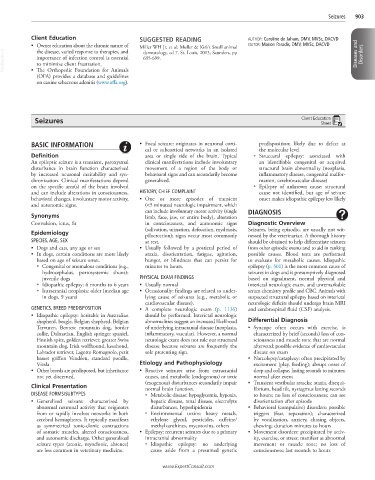Page 1804 - Cote clinical veterinary advisor dogs and cats 4th
P. 1804
Seizures 903
Client Education SUGGESTED READING AUTHOR: Caroline de Jaham, DMV, MVSc, DACVD
• Owner education about the chronic nature of Miller WH Jr, et al: Muller & Kirk’s Small animal EDITOR: Manon Paradis, DMV, MVSc, DACVD
VetBooks.ir importance of infection control is essential 695-699. Diseases and Disorders
the disease, varied response to therapies, and
dermatology, ed 7, St. Louis, 2013, Saunders, pp
to minimize client frustration.
• The Orthopedic Foundation for Animals
(OFA) provides a database and guidelines
on canine sebaceous adenitis (www.offa.org).
Seizures Client Education
Sheet
BASIC INFORMATION • Focal seizure: originates in neuronal corti- predisposition; likely due to defect at
cal or subcortical networks in an isolated the molecular level
Definition area or single side of the brain. Typical ○ Structural epilepsy: associated with
An epileptic seizure is a transient, paroxysmal clinical manifestations include involuntary an identifiable congenital or acquired
disturbance in brain function characterized movement of a region of the body or structural brain abnormality (neoplasia,
by increased neuronal excitability and syn- behavioral signs and can secondarily become inflammatory disease, congenital malfor-
chronization. Clinical manifestations depend generalized. mation, cerebrovascular disease)
on the specific area(s) of the brain involved ○ Epilepsy of unknown cause: structural
and can include alterations in consciousness, HISTORY, CHIEF COMPLAINT cause not identified, but age of seizure
behavioral changes, involuntary motor activity, • One or more episodes of transient onset makes idiopathic epilepsy less likely
and autonomic signs. (<5 minutes) neurologic impairment, which
can include involuntary motor activity (single DIAGNOSIS
Synonyms limb, face, jaw, or entire body), alteration
Convulsion, ictus, fit in consciousness, and autonomic signs Diagnostic Overview
(salivation, urination, defecation, mydriasis, Seizures, being episodic, are usually not wit-
Epidemiology piloerection); signs occur most commonly nessed by the veterinarian. A thorough history
SPECIES, AGE, SEX at rest. should be obtained to help differentiate seizures
• Dogs and cats, any age or sex • Usually followed by a postictal period of from other episodic events and to aid in ranking
• In dogs, certain conditions are more likely ataxia, disorientation, fatigue, agitation, possible causes. Blood tests are performed
based on age of seizure onset. hunger, or blindness that can persist for to evaluate for metabolic causes. Idiopathic
○ Congenital or anomalous conditions (e.g., minutes to hours. epilepsy (p. 301) is the most common cause of
hydrocephalus, portosystemic shunt): seizures in dogs and is presumptively diagnosed
juvenile dogs PHYSICAL EXAM FINDINGS based on signalment, normal physical and
○ Idiopathic epilepsy: 6 months to 6 years • Usually normal interictal neurologic exam, and unremarkable
○ Intracranial neoplasia: older (median age • Occasionally: findings are related to under- serum chemistry profile and CBC. Animals with
in dogs, 9 years) lying cause of seizures (e.g., metabolic or suspected structural epilepsy based on interictal
cardiovascular disease). neurologic deficits should undergo brain MRI
GENETICS, BREED PREDISPOSITION • A complete neurologic exam (p. 1136) and cerebrospinal fluid (CSF) analysis.
• Idiopathic epilepsy: heritable in Australian should be performed. Interictal neurologic
shepherd, beagle, Belgian shepherd, Belgian abnormalities suggest an increased likelihood Differential Diagnosis
Tervuren, Bernese mountain dog, border of underlying intracranial disease (neoplasia, • Syncope often occurs with exercise, is
collie, Dalmatian, English springer spaniel, inflammatory, vascular). However, a normal characterized by brief (seconds) loss of con-
Finnish spitz, golden retriever, greater Swiss neurologic exam does not rule out structural sciousness and muscle tone that are normal
mountain dog, Irish wolfhound, keeshond, disease because seizures are frequently the afterward; possible evidence of cardiovascular
Labrador retriever, Lagotto Romagnolo, petit sole presenting sign. disease on exam
basset griffon Vendéen, standard poodle, • Narcolepsy/cataplexy: often precipitated by
Vizsla Etiology and Pathophysiology excitement (play, feeding); abrupt onset of
• Other breeds are predisposed, but inheritance • Reactive seizures arise from extracranial sleep and collapse, lasting seconds to minutes;
not yet discerned. causes, and metabolic (endogenous) or toxic normal after event
(exogenous) disturbances secondarily impair • Transient vestibular attacks: ataxia, disequi-
Clinical Presentation normal brain function. librium, head tilt, nystagmus lasting seconds
DISEASE FORMS/SUBTYPES ○ Metabolic disease: hypoglycemia, hypoxia, to hours; no loss of consciousness; can see
• Generalized seizure: characterized by hepatic disease, renal disease, electrolyte disorientation after episode
abnormal neuronal activity that originates disturbances, hyperlipidemia • Behavioral (compulsive) disorders: possible
from or rapidly involves networks in both ○ Environmental toxins: heavy metals, triggers (fear, separation); characterized
cerebral hemispheres. It typically manifests ethylene glycol, pesticides, caffeine/ by vocalization, anxiety, chasing objects,
as symmetrical tonic-clonic contractions methylxanthines, mycotoxins, others chewing; duration minutes to hours
of somatic muscles, altered consciousness, • Epilepsy: recurrent seizures due to a primary • Movement disorders: precipitated by activ-
and autonomic discharge. Other generalized intracranial abnormality ity, exercise, or stress; manifest as abnormal
seizure types (atonic, myoclonic, absence) ○ Idiopathic epilepsy: no underlying movement or muscle tone; no loss of
are less common in veterinary medicine. cause aside from a presumed genetic consciousness; last seconds to hours
www.ExpertConsult.com

